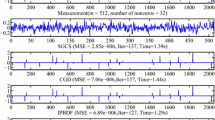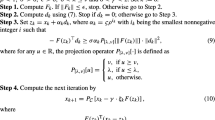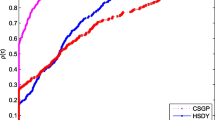Abstract
In this paper, the subgradient projection iteration is used to find an approximation solution of a weighted least-squares problem with respect to linear imaging system. Instead of an exact or approximate line search in each iteration, the step length in this paper is fixed by the weighted least-square function and the current iteration. Using weighted singular value decomposition, we estimate the bounds of step length. Consequently, we provide the decreasing property and the sufficient condition for convergence of the iterative algorithm. Furthermore, we perform a numerical experiment on a two dimensional image reconstruction problem to confirm the validity of this subgradient projection iteration.


Similar content being viewed by others
References
Herman, G.T.: Image Reconstruction from Projections: The Fundamentals of Computerized Tomography. Academic Press, New York (1980)
Natterer, F., Wubbeling, F.: Mathematical Methods in Image Reconstruction. Society for Industrial and Applied Mathematics, Philadelphia (2001)
Censor, Y., Herman, G.T.: On some optimization techniques in image reconstruction from projections. Appl. Numer. Math. 3(5), 365–391 (1987)
Olver, P.J., Shakiban, C.: Applied Linear Algebra. Prentice-Hall, Upper Saddle River (2006)
Golub, G.G., Van Loan, C.F.: Matrix Computations, 4th edn. The Johns Hopkins University Press, Baltimore (2013)
Jiang, M., Wang, G.: Convergence studies on iterative algorithms for image reconstruction. IEEE Trans. Med. Imaging 22(5), 569–579 (2003)
Qu, G., Wang, C., Jiang, M.: Necessary and sufficient convergence conditions for algebraic image reconstruction algorithms. IEEE Trans. Image Process. 18(2), 435–440 (2009)
Wang, M., Polydorides, N., Bertsekas, D.P.: Approximate simulation-based solution of large-scale least squares problems. Lab. for Information and Decision Systems Report LIDS-P-2819, MIT (2009)
Balabdaoui, F., Rufibach, K., Santambrogio, F.: Least-squares estimation of two-ordered monotone regression curves. J. Nonparametric Stat. 22(8), 1019–1037 (2010)
Freund, R.M., Grigas, P., Mazumder, R.: A new perspective on boosting in linear regression via subgradient optimization and relatives. Ann. Stat. 45(6), 2328–2364 (2017)
Yu, H., Bertsekas, D.P.: Convergence results for some temporal difference methods based on least squares. IEEE Trans. Autom. Control 54(7), 1515–1531 (2009)
Kiwiel, K.C.: Convergence of approximate and incremental subgradient methods for convex optimization. SIAM J. Optim. 14(3), 807–840 (2004)
Dang, Y., Gao, Y.: A new simultaneous subgradient projection algorithm for solving a multiple-sets split feasibility problem. Appl. Math. 59(1), 37–51 (2014)
Gondzio, J., Vial, J.P.: Warm start and \(\varepsilon \)-subgradients in a cutting plane scheme for block-angular linear programs. Comput. Optim. Appl. 14(1), 17–36 (1999)
Vershinin, Y.N., Bykov, A.A., Krutikov, V.N., Meshechkin, V.V.: On the subgradient method solution of regularized linear programming problem in the environmental monitoring system. Kemerovo State Univ. Bull. 1(1), p35 (2014)
Renegar, J.: A framework for applying subgradient methods to conic optimization problems. (2015) arXiv:1503.02611
Schuurmans, D., Southey, F., Holte, R.C.: The exponentiated subgradient algorithm for heuristic boolean programming. In: International Joint Conference on Artificial Intelligence, pp. 334–341 (2001)
Onnheim, M., Gustavsson, E., Stromberg, A.B., Patriksson, M., Larsson, T.: Ergodic, primal convergence in dual subgradient schemes for convex programming, II: the case of inconsistent primal problems. Math. Program. 163(1–2), 57–84 (2017)
Wang, G., Zhang, H., Yu, S., Ding, S.: A family of the subgradient algorithm with several cosparsity inducing functions to the cosparse recovery problem. Pattern Recognit. Lett. 80, 64–69 (2016)
Kirsch, A.: An Introduction to the Theory of Mathematical Inverse Problems, Volume 120 of Applied Mathematical Sciences., 2nd edn. Springer, New York (2011)
Wang, G.: Perturbation theory for weighted Moore-Penrose inverse. Commun. Appl. Math. Comput. 1(1), 48–60 (1981)
Wei, Y., Wang, G.: PCR algorithm for parallel computing minimum-norm (T) least-squares (S) solution of inconsistent linear equations. Appl. Math. Comput. 133(2), 547–557 (2002)
Cegielski, A.: Iterative Methods for Fixed Point Problems in Hilbert Spaces. Springer, New York (2013)
Bauschke, H.H., Wang, C., Wang, X., Xu, J.: On subgradient projectors. SIAM J. Optim. 25(2), 1064–1082 (2015)
Byrne, C.: Iterative oblique projection onto convex sets and the split feasibility problem. Inverse Probl. 18(2), 441–453 (2002)
Byrne, C.: A unified treatment of some iterative algorithms in signal processing and image reconstruction. Inverse Probl. 20(1), 103–120 (2004)
López, G., Martínmárquez, V., Wang, F., Xu, H.-K.: Solving the split feasibility problem without prior knowledge of matrix norms. Inverse Probl. 28(8), 374–389 (2012)
Cegielski, A.: Landweber-type operator and its properties. In: Panorama of Mathematics: Pure and Applied, volume 658 of Contemporary Mathematics, pp. 139–148 (2016)
Van Loan, C.F.: Generalizing the singular value decomposition. SIAM J. Numer. Anal. 13(1), 76–83 (1976)
Han, G., Qu, G., Jiang, M.: Relaxation strategy for the Landweber method. Signal Process. 125, 87–96 (2016)
Bauschke, H.H., Wang, C., Wang, X., Xu, J.: On the finite convergence of a projected cutter method. J. Optim. Theory Appl. 165(3), 901–916 (2015)
Acknowledgements
Caifang Wang is supported by National Natural Science Foundation of China (11401372).
Author information
Authors and Affiliations
Corresponding author
Rights and permissions
About this article
Cite this article
Wang, C. Properties of subgradient projection iteration when applying to linear imaging system. Optim Lett 13, 1285–1297 (2019). https://doi.org/10.1007/s11590-018-1321-3
Received:
Accepted:
Published:
Issue Date:
DOI: https://doi.org/10.1007/s11590-018-1321-3




